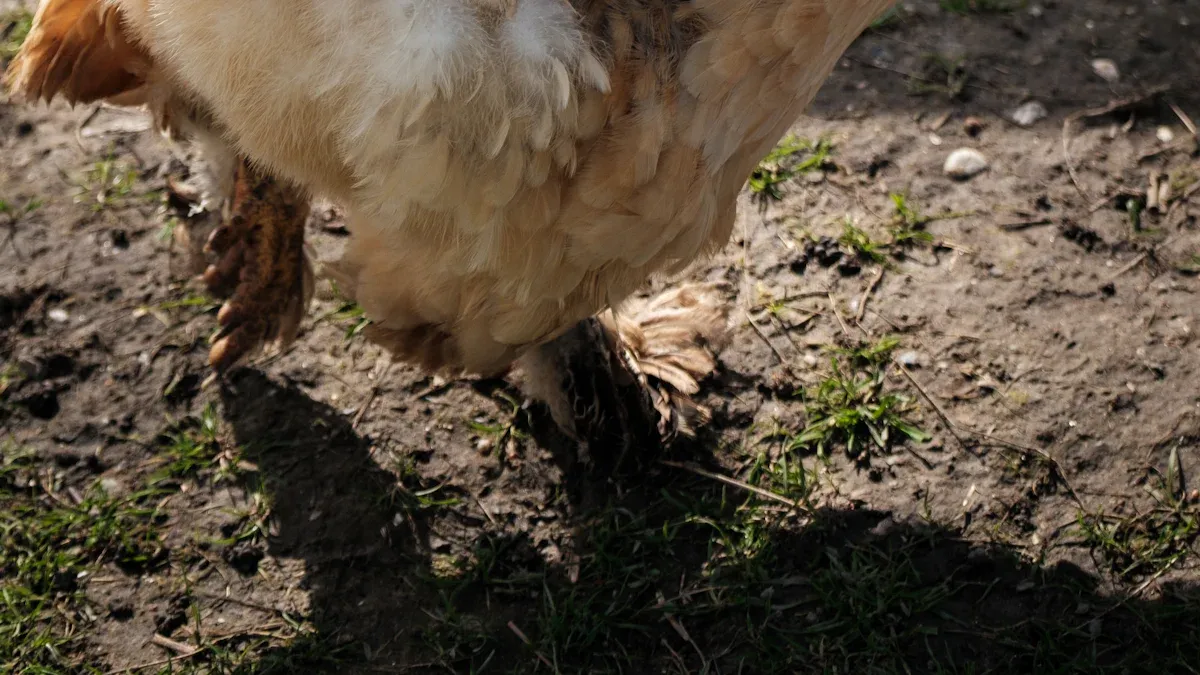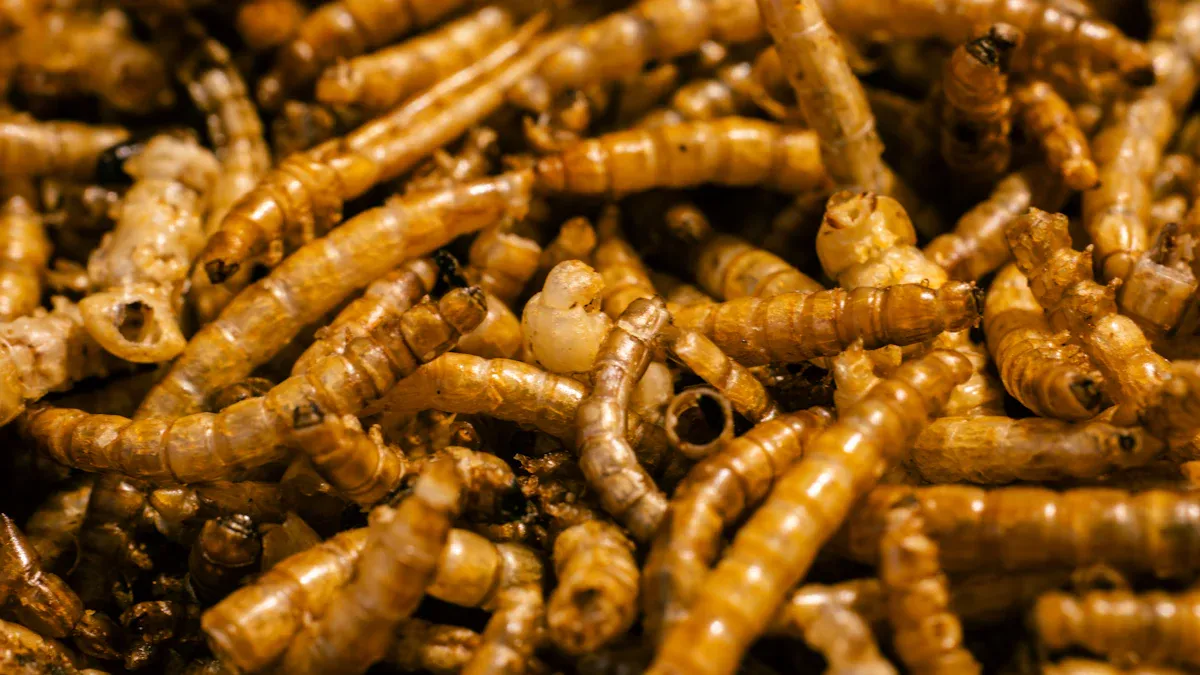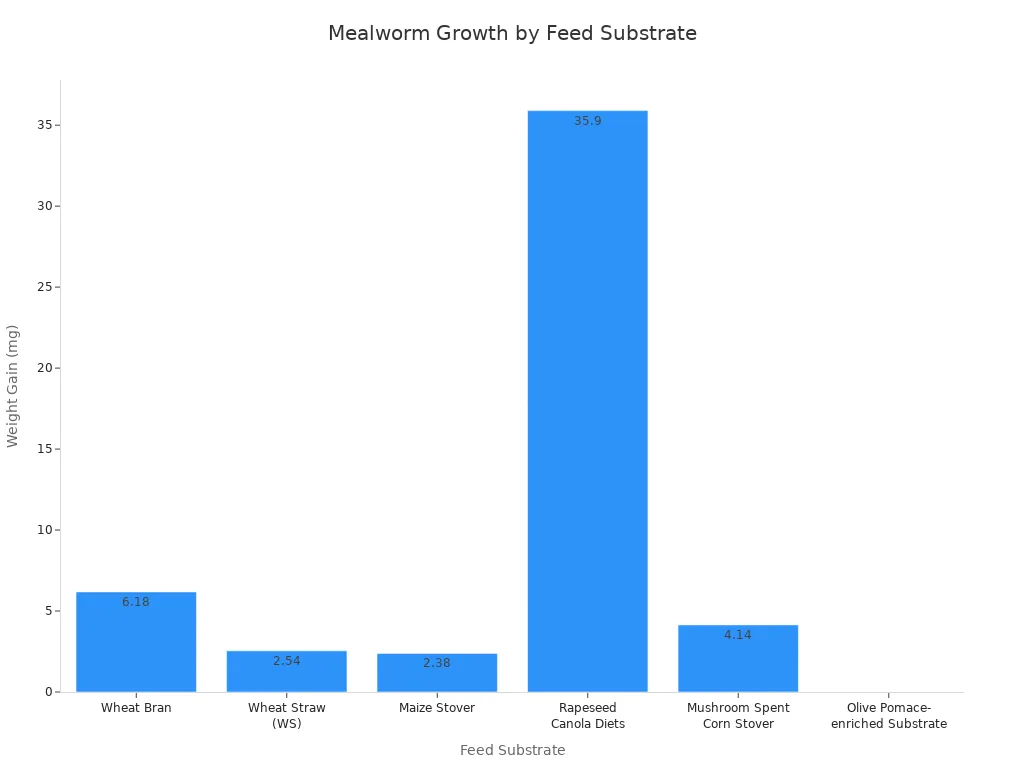
Mealworms for Poultry feed give flocks a powerful boost. Birds show impressive growth and health when mealworms become part of their daily diet. Studies found that chicks gained more weight and used feed better with mealworm meal. This natural supplement delivers high protein and essential nutrients for vibrant, thriving poultry.
Key Takeaways
- Mealworms provide high-quality protein and essential nutrients that boost poultry growth, improve egg quality, and support strong feathers and immunity.
- Poultry owners can buy or raise mealworms at home, but must prepare them properly by purging, freezing, and cooking to ensure safety and nutrition.
- Feed mealworms as a treat two to three times a week, keeping them under 10% of the daily diet to maintain balance and avoid health problems.
Mealworms for Poultry Feed: Benefits and Nutritional Value

Protein and Essential Nutrients for Growth
Mealworms for Poultry feed deliver a powerful source of protein, which is essential for healthy growth and development. Mealworms contain between 46% and 53% protein, making them one of the richest protein sources available for birds. This high-quality protein supports muscle growth, feather development, and body repair. In addition to protein, mealworms provide essential amino acids, vitamins, and minerals such as calcium and iron. These nutrients help prevent deficiencies and keep birds strong and active.
| Poultry Feed Supplement | Protein Content Range (% dry matter basis) |
|---|---|
| Yellow Mealworm Larvae | 38.9 – 76.2 |
| Soybean Meal | 44.9 – 49.4 |
| Fish Meal | 42.7 – 72.0 |
| Black Soldier Fly Larvae | 29.9 – 48.9 |
| House Fly Larvae | 42.4 – 64.6 |
| Conventional Chicken Feed | 18.2 – 23.2 |
Mealworms for Poultry feed stand out as a top choice for boosting nutrition in any flock.
Improved Egg Production and Feather Quality
Birds that receive mealworms often lay more eggs with richer yolk color and stronger shells. The essential fatty acids in mealworms improve egg quality, while the protein helps hens maintain their condition during laying. During molting, mealworms support feather regrowth, giving birds a healthy, glossy appearance. Many poultry keepers notice brighter feathers and better overall health after adding mealworms to the diet.
Supports Immune System and Natural Foraging
Mealworms contain nutrients that help strengthen the immune system. Healthier birds resist disease and infection more easily. The chitin in mealworms also supports gut health by reducing harmful bacteria. Scattering mealworms encourages natural foraging, which keeps birds active and reduces stress. This simple supplement brings out the best in every flock.
How to Source, Prepare, and Feed Mealworms to Poultry
Sourcing or Raising Mealworms at Home
Poultry owners can choose to buy mealworms from trusted suppliers or raise them at home. Fluker Farms stands out as a reliable source for purchasing live mealworms. With over 65 years of experience, they provide USA-grown mealworms that arrive healthy and ready to feed. Their customer support and delivery guarantees give peace of mind to poultry keepers.
Many people also enjoy raising mealworms at home. This method offers a steady supply and allows control over the mealworms’ diet. To start, use a substrate such as wheat bran, corn meal, or store-bought mealworm bedding. Some people use chicken feed that has been frozen to kill pests. Mealworms thrive on root vegetables, fruit peels, and other vegetable scraps. Fresh greens like sweet potatoes and kale provide moisture without the need for a water bowl. Keep the temperature between 70 and 80 degrees Fahrenheit for best results. Separate the larvae from the beetles, since only the larvae should be fed to poultry. Expect female beetles to lay up to 500 eggs, with larvae appearing in two to three weeks. If there are too many mealworms, poultry will happily eat the surplus as a treat.
Tip: Use containers with good ventilation and avoid overcrowding. This keeps the mealworms healthy and prevents mold.
Preparing Mealworms for Poultry Feed
Proper preparation ensures mealworms are safe and nutritious for poultry. Before feeding, purge the mealworms by withholding food for one to two days. This step cleans their digestive tracts. Next, freeze the mealworms at -10° to -20° Celsius for one to two days. Freezing humanely kills the mealworms and prevents revival. Boil the mealworms for three minutes to remove dirt and kill any parasites. After boiling, dehydrate or fry the mealworms to improve taste and shelf life. These steps help maintain the safety and nutritional value of Mealworms for Poultry feed.
Recommended Quantities and Feeding Frequency
Mealworms are rich in protein, so a small amount goes a long way. For an average chicken, feeding between 1 to 10 mealworms at a time boosts protein intake and supports growth. Experts recommend offering mealworms as a treat two to three times per week. The amount should not exceed 10 mealworms per chicken per feeding. Mealworms should make up less than 10% of the daily food intake. This keeps the diet balanced and prevents health problems. Rotate mealworms with other healthy snacks, such as fresh greens, to provide variety.
| Poultry Type | Recommended Mealworms per Feeding | Frequency | Notes |
|---|---|---|---|
| Chicken | 1–10 | 2–3 times per week | Less than 10% of daily food intake |
| Duck | 1–10 | 2–3 times per week | Adjust based on size and activity |
| Quail | 1–5 | 2–3 times per week | Smaller amounts for smaller birds |
Note: Mealworms for Poultry feed work best as a supplement, not a replacement for the main diet.
Best Ways to Incorporate Mealworms into Poultry Diets
Mealworms can be offered in several fun and effective ways. Scatter dried or live mealworms in the coop or run to encourage natural foraging. This activity keeps birds active and reduces stress. Mix mealworms into regular feed to boost protein content. Some poultry owners use treat dispensers or foraging toys to make feeding time more engaging. These methods help birds stay healthy, happy, and productive.
🐔 Inspiration: Many poultry keepers notice brighter feathers, stronger eggs, and more active flocks after adding mealworms to their birds’ diets. With the right approach, anyone can unlock these benefits for their flock.
Monitoring Poultry Health and Avoiding Common Mistakes
Tracking Growth and Health Improvements
Poultry owners who supplement with mealworms often see positive changes in their flocks. Careful monitoring helps ensure birds thrive. Daily checks create a routine that supports healthy growth. Owners can use several techniques to track progress:
- Observe environmental conditions each day.
- Record mortality rates to spot trends early.
- Watch for signs of illness, such as lethargy or changes in appetite.
- Notice bird behaviors like preening, foraging, and feather pecking.
- Check plumage for shine and fullness.
- Monitor leg health for strength and mobility.
- Some advanced keepers measure stress by checking excreta corticosterone levels.
These steps help owners celebrate improvements and catch problems quickly.
Signs of Overfeeding or Imbalance
Mealworms provide excellent nutrition, but moderation is key. Overfeeding can lead to health issues. Owners should watch for these warning signs:
- Birds may develop urinary problems from too many minerals and proteins.
- Overweight hens risk fatty liver hemorrhagic syndrome, which can be fatal.
- Egg quality may drop, with bloodstained eggs or weaker shells.
- Extra fat can cause egg binding, making laying difficult.
- Obesity may lead to inactivity, oversized eggs, and more waste in the coop.
- Kidney disease and gout can develop from too much protein.
Limiting mealworms to about 10% of daily intake keeps birds healthy and active.
Common Mistakes to Avoid with Mealworms for Poultry Feed
Success with mealworms comes from good management. Some common mistakes can hinder results:
- Adding too many vegetable scraps to mealworm bedding causes mold growth.
- Keeping mealworms in a cold environment prevents larvae from hatching.
By maintaining a clean, warm setup and feeding mealworms in moderation, poultry owners set their flocks up for lasting success. Mealworms for Poultry feed, when used wisely, inspire healthier, happier birds every day.
Mealworms for Poultry feed help birds grow stronger and healthier. Studies show better weight gain, improved eggs, and stronger immunity. The table below highlights these long-term benefits:
| Benefit Category | Description of Long-Term Benefits |
|---|---|
| Growth Performance | Improved body weight and feed conversion |
| Immune System Traits | Enhanced resistance and gut health |
| Egg Quality | Higher fatty acid profile and better eggs |

With the right sourcing and preparation, flocks thrive. Many poultry owners see brighter feathers, better growth, and happier birds.
FAQ
Can all types of poultry eat mealworms?
Yes. Chickens, ducks, and quail all enjoy mealworms. Mealworms for Poultry feed provide safe, nutritious protein for every flock.
How should owners store dried mealworms?
Store dried mealworms in a cool, dry place. Use an airtight container. This keeps mealworms fresh and ready for every feeding.
Will mealworms improve egg quality?
Many poultry owners see brighter yolks and stronger shells after adding mealworms for Poultry feed. Birds often lay more eggs with better nutrition.


